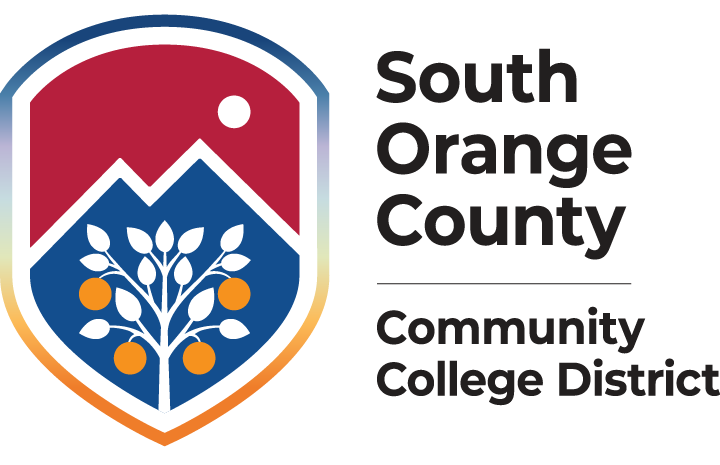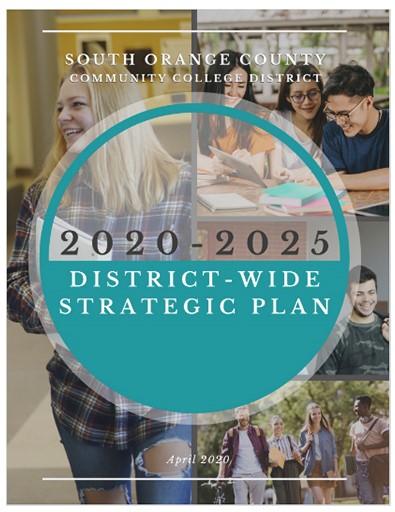District-wide Strategic Plan 2020-2025
The SOCCCD District-wide Strategic Plan 2020-2025 was developed in concert with Saddleback College and Irvine Valley College and reflects district-wide planning priorities. The District-wide Strategic Plan is managed by the District-wide Planning Council, a participatory governance group.
A comprehensive SOCCCD Environmental Scan Report 2019 to inform the District and college strategic plans was conducted in 2019.
District-wide Goals and Objectives
Strategic Planning Goals 2014-2025
Desired Outcome: All students have been provided equal access to quality education and traditionally underrepresented students have achieved their desired educational outcomes to the same extent and at the same rate as all other students.
OBJECTIVES
-
1.1 Reduce and eliminate the achievement gap among underrepresented students. Indicator: Reduce and eliminate the achievement gap among underrepresented students in the number of students annually who earn associate degrees, certificates, transfer, become transfer ready, or complete 9 units in a CTE program that prepares them for a specific occupation
-
1.2 Reduce and eliminate the achievement gap for completion rates in transfer-level math and English (VFS). Indicator: Increase the completion rate of transfer-level math and English within students’ first year to 50 percent
-
1.3 Reduce and eliminate the achievement gap between online and traditional classroom classes. Indicator: Establish baseline data set for each college and district-wide
-
1.4 Increase equity of access into college. Indicator: Establish a baseline for the overall percentage of students who enroll after applying and by underrepresented student groups
-
1.5 Reduce and eliminate student Fall to Spring and Fall to Fall retention equity gaps. Indicator: Establish a baseline for student retention rates by underrepresented student groups
-
1.6 Cultivate culturally responsive and inclusive learning and working environment free from explicit/implicit bias. Indicator: Establish a baseline to measure explicit/implicit bias
-
1.7 Cultivate a culturally responsive and inclusive learning and working environment free from institutional bias. Indicator: Establish a baseline to measure culturally responsive and inclusive learning environment
Desired Outcome: The lives of our students are transformed by the learning opportunities they experience, the skills they acquire, and the achievements they attain.
OBJECTIVES
-
2.1 Increase the number of students annually who earn associate degrees, certificates, or 9 units in a CTE program that prepare them for an in-demand job (VFS). Indicator: Establish a baseline of completion by award type and CTE program
-
2.2 Increase the number of students transferring annually (VFS). Indicator: Increase transfers to UC, CSU, and all other institutions by 35% Indicator: Establish a baseline to measure “transfer ready” students
-
2.3 Increase completion rates in transfer-level math and English. Indicator: Increase the completion rate of transfer-level math and English within students’ first year to 50 percent
-
2.4 Increase course success in online and traditional classroom classes. Indicator: Establish a baseline for course success in online and traditional classes
-
2.5 Increase student spring to spring and fall to fall retention. Indicator: Establish baseline percentage for the student retention rates
-
2.6 Increase the percent of exiting CTE students who report being employed in their field of study(VFS). Indicator: Increase CTE employment rate to 69 percent
-
2.7 Reduce average units accumulated by students who complete degrees (VFS). Indicator: Reduce average units accumulated from 88 to 79 units
-
2.8 Implement educational programs and student services to indicator non-traditional students. Indicator: Establish baseline of "non-traditional" students
-
2.9 Increase and support the number of outside classroom learning opportunities available for students in each division (and participation in those opportunities). Indicator: Establish a baseline of "outside learning opportunities"
-
2.10 Create and support inter-disciplinary learning opportunities both within and across the colleges. Indicator: Establish a baseline for inter-disciplinary learning opportunities
-
2.11 Increase the number of professional development opportunities for faculty and staff. Indicator: Establish a baseline for professional development programs
Desired Outcome: Strategic partnerships enable us to serve the civic, cultural, and economic needs of our communities.
OBJECTIVES
-
3.1 Strengthen and expand industry engagement to support student learning, program development, and regional economic development. Indicator: Establish baseline counts of partnerships by developing a rubric to categorize existing partnerships
-
3.2 Increase the number of students who reported obtaining a job closely related to their field of study that strongly support the regional economy (VFS). Indicator: Increase the percentage of students reporting obtaining a job closely related to their field of study to 76% based on Career Technical Education Outcomes Survey (CTEOS)
-
3.3 Increase participation in extended learning (community and adult education programs, and emeritus institutes). Indicator: Establish a baseline for extended learning programs
-
3.4 Increase the number of students who earn college credits while still in high school. Indicator: Establish a baseline of students who are dual-enrolled (CCAP) and concurrently enrolled
-
3.5 Increase partnerships with higher education institutions. Indicator: Establish a baseline of partnerships with higher education institutions
-
3.6 Increase community participation in civic, athletic, and cultural events. Indicator: Establish a baseline for measuring community participation in civic, athletic, and cultural activities.
Desired Outcome: Our institutional systems, facilities, and infrastructure are optimized, accessible, and sustainable to achieve our goals.
OBJECTIVES
-
4.1 Identify and streamline all institutional policies, practices, and processes pertaining to facilities and technology. Indicator: Completion of college and district facilities and technology master plans that include a student-centered principle, established standards, and an appropriate resource planning model
-
4.2 Develop an organizational culture of collaboration across the district Indicator: Implement the District-wide Climate Survey in 2020 to establish a baseline on organizational culture and collaboration
-
4.3 Create a sustainable and robust participatory governance evaluation process Indicator: Review and analyze all committee evaluations for effective participatory governance and decision-making
-
4.4 Provide enhanced student support with a student-centered design Indicator: Establish areas of student need for expanded student support services Indicator: Explore student housing feasibility in the district
-
4.5 Develop and build out the ATEP vision for the colleges including public-private partnerships Indicator: Establish a baseline of deliverables for ATEP vision

